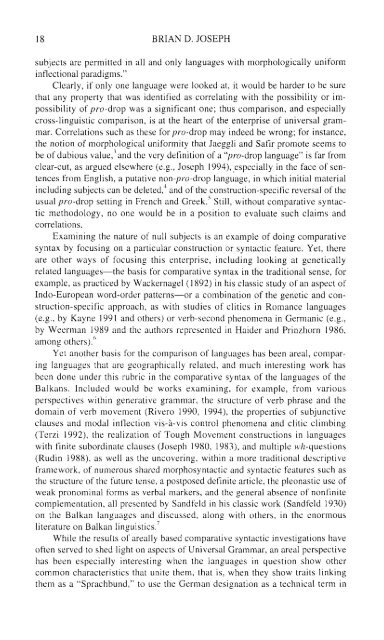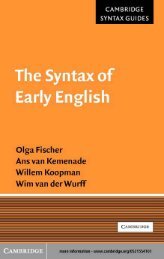Comparative Syntax of the Balkan Languages (Oxford ... - Cryptm.org
Comparative Syntax of the Balkan Languages (Oxford ... - Cryptm.org
Comparative Syntax of the Balkan Languages (Oxford ... - Cryptm.org
- No tags were found...
Create successful ePaper yourself
Turn your PDF publications into a flip-book with our unique Google optimized e-Paper software.
18 BRIAN D. JOSEPHsubjects are permitted in all and only languages with morphologically uniforminflectional paradigms."Clearly, if only one language were looked at, it would be harder to be surethat any property that was identified as correlating with <strong>the</strong> possibility or impossibility<strong>of</strong> pro-drop was a significant one; thus comparison, and especiallycross-linguistic comparison, is at <strong>the</strong> heart <strong>of</strong> <strong>the</strong> enterprise <strong>of</strong> universal grammar.Correlations such as <strong>the</strong>se for pro-drop may indeed be wrong; for instance,<strong>the</strong> notion <strong>of</strong> morphological uniformity that Jaeggli and Safir promote seems tobe <strong>of</strong> dubious value, and <strong>the</strong> very definition <strong>of</strong> a "pro-drop language" is far fromclear-cut, as argued elsewhere (e.g., Joseph 1994), especially in <strong>the</strong> face <strong>of</strong> sentencesfrom English, a putative non-pro-drop language, in which initial materialincluding subjects can be deleted, and <strong>of</strong> <strong>the</strong> construction-specific reversal <strong>of</strong> <strong>the</strong>usual pro-drop setting in French and Greek. 1 Still, without comparative syntacticmethodology, no one would be in a position to evaluate such claims andcorrelations.Examining <strong>the</strong> nature <strong>of</strong> null subjects is an example <strong>of</strong> doing comparativesyntax by focusing on a particular construction or syntactic feature. Yet, <strong>the</strong>reare o<strong>the</strong>r ways <strong>of</strong> focusing this enterprise, including looking at geneticallyrelated languages—<strong>the</strong> basis for comparative syntax in <strong>the</strong> traditional sense, forexample, as practiced by Wackernagel (1892) in his classic study <strong>of</strong> an aspect <strong>of</strong>Indo-European word-order patterns—or a combination <strong>of</strong> <strong>the</strong> genetic and construction-specificapproach, as with studies <strong>of</strong> clitics in Romance languages(e.g., by Kayne 1991 and o<strong>the</strong>rs) or verb-second phenomena in Germanic (e.g.,by Weerman 1989 and <strong>the</strong> authors represented in Haider and Prinzhorn 1986,among o<strong>the</strong>rs). 6Yet ano<strong>the</strong>r basis for <strong>the</strong> comparison <strong>of</strong> languages has been areal, comparinglanguages that are geographically related, and much interesting work hasbeen done under this rubric in <strong>the</strong> comparative syntax <strong>of</strong> <strong>the</strong> languages <strong>of</strong> <strong>the</strong><strong>Balkan</strong>s. Included would be works examining, for example, from variousperspectives within generative grammar, <strong>the</strong> structure <strong>of</strong> verb phrase and <strong>the</strong>domain <strong>of</strong> verb movement (Rivero 1990, 1994), <strong>the</strong> properties <strong>of</strong> subjunctiveclauses and modal inflection vis-a-vis control phenomena and clitic climbing(Terzi 1992), <strong>the</strong> realization <strong>of</strong> Tough Movement constructions in languageswith finite subordinate clauses (Joseph 1980, 1983), and multiple wh-questions(Rudin 1988), as well as <strong>the</strong> uncovering, within a more traditional descriptiveframework, <strong>of</strong> numerous shared morphosyntactic and syntactic features such as<strong>the</strong> structure <strong>of</strong> <strong>the</strong> future tense, a postposed definite article, <strong>the</strong> pleonastic use <strong>of</strong>weak pronominal forms as verbal markers, and <strong>the</strong> general absence <strong>of</strong> nonfinitecomplementation, all presented by Sandfeld in his classic work (Sandfeld 1930)on <strong>the</strong> <strong>Balkan</strong> languages and discussed, along with o<strong>the</strong>rs, in <strong>the</strong> enormous7literature on <strong>Balkan</strong> linguistics.While <strong>the</strong> results <strong>of</strong> areally based comparative syntactic investigations have<strong>of</strong>ten served to shed light on aspects <strong>of</strong> Universal Grammar, an areal perspectivehas been especially interesting when <strong>the</strong> languages in question show o<strong>the</strong>rcommon characteristics that unite <strong>the</strong>m, that is, when <strong>the</strong>y show traits linking<strong>the</strong>m as a "Sprachbund," to use <strong>the</strong> German designation as a technical term in
















